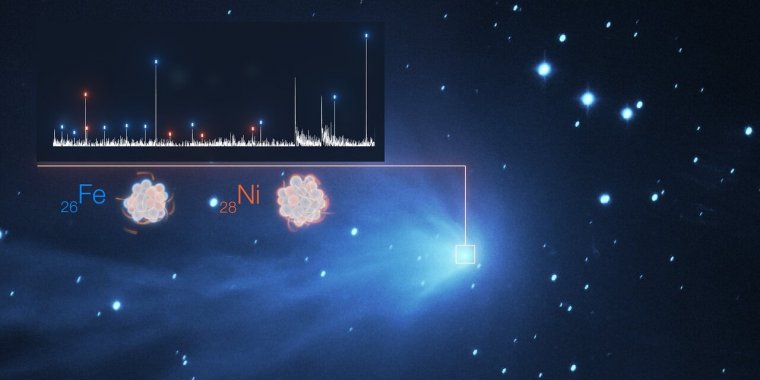| News / Science News |
Heavy metal vapours unexpectedly found in comets throughout our Solar System — and beyond
A new study by a Belgian team using data from the European Southern Observatory’s Very Large Telescope (ESO’s VLT) has shown that iron and nickel exist in the atmospheres of comets throughout our Solar System, even those far from the Sun. A separate study by a Polish team, who also used ESO data, reported that nickel vapour is also present in the icy interstellar comet 2I/Borisov. This is the first time heavy metals, usually associated with hot environments, have been found in the cold atmospheres of distant comets.

Detection of heavy metals in the atmosphere of comet C/2016 R2. Photo: ESO
Astronomers know that heavy metals exist in comets’ dusty and rocky interiors. But, because solid metals don’t usually “sublimate” (become gaseous) at low temperatures, they did not expect to find them in the atmospheres of cold comets that travel far from the Sun.
Nickel and iron vapours have now even been detected in comets observed at more than 480 million kilometres from the Sun, more than three times the Earth-Sun distance.
The Belgian team found iron and nickel in comets’ atmospheres in approximately equal amounts. Material in our Solar System, for example that found in the Sun and in meteorites, usually contains about ten times more iron than nickel.
This new result therefore has implications for astronomers’ understanding of the early Solar System, though the team is still decoding what these are.
“Comets formed around 4.6 billion years ago, in the very young Solar System, and haven’t changed since that time. In that sense, they’re like fossils for astronomers,” says study co-author Emmanuel Jehin, from the University of Liège.
The team used data from the Ultraviolet and Visual Echelle Spectrograph (UVES) instrument on ESO’s VLT, which uses a technique called spectroscopy, to analyse the atmospheres of comets at different distances from the Sun.
This technique allows astronomers to reveal the chemical makeup of cosmic objects: each chemical element leaves a unique signature — a set of lines — in the spectrum of the light from the objects.
The Belgian team had spotted weak, unidentified spectral lines in their UVES data and on closer inspection noticed that they were signalling the presence of neutral atoms of iron and nickel.
A reason why the heavy elements were difficult to identify is that they exist in very small amounts: the team estimates that for each 100 kg of water in the comets’ atmospheres there is only 1 g of iron, and about the same amount of nickel.
“Usually there is 10 times more iron than nickel, and in those comet atmospheres we found about the same quantity for both elements. We came to the conclusion they might come from a special kind of material on the surface of the comet nucleus, sublimating at a rather low temperature and releasing iron and nickel in about the same proportions,” explains Damien Hutsemékers, a member of the Belgian team from the University of Liège.
Another remarkable study shows that heavy metals are also present in the atmosphere of the interstellar comet 2I/Borisov. A team in Poland observed this object, the first alien comet to visit our Solar System, using the X-shooter spectrograph on ESO’s VLT when the comet flew by about a year and a half ago. They found that 2I/Borisov’s cold atmosphere contains gaseous nickel.
“At first we had a hard time believing that atomic nickel could really be present in 2I/Borisov that far from the Sun. It took numerous tests and checks before we could finally convince ourselves,” says study author Piotr Guzik from the Jagiellonian University in Poland. The finding is surprising because, before the two studies, gases with heavy metal atoms had only been observed in hot environments, such as in the atmospher of ultra-hot exoplanets or evaporating comets that passed too close to the Sun. 2I/Borisov was observed when it was some 300 million kilometres away from the Sun, or about twice the Earth-Sun distance. (ESO)
YOU MAY ALSO LIKE





